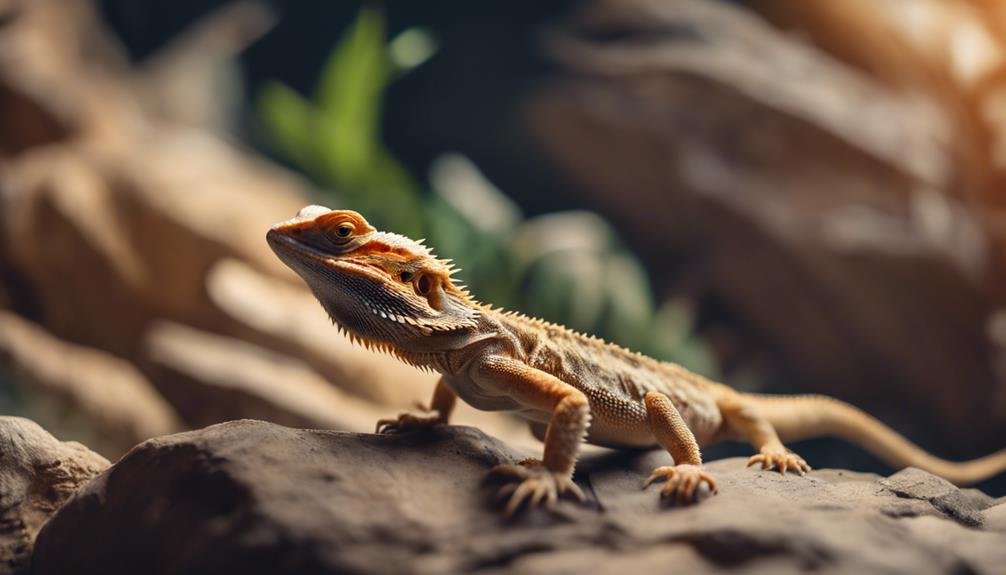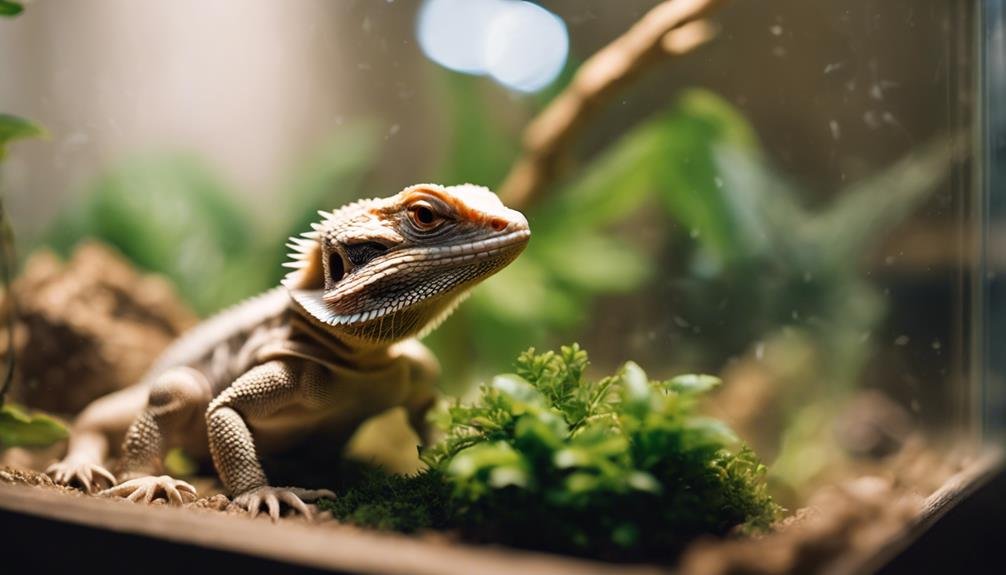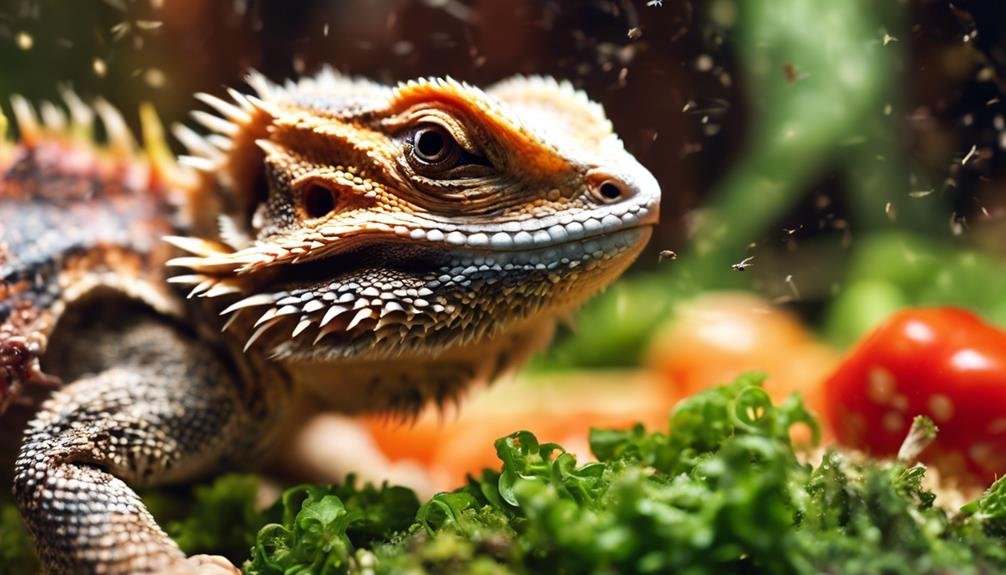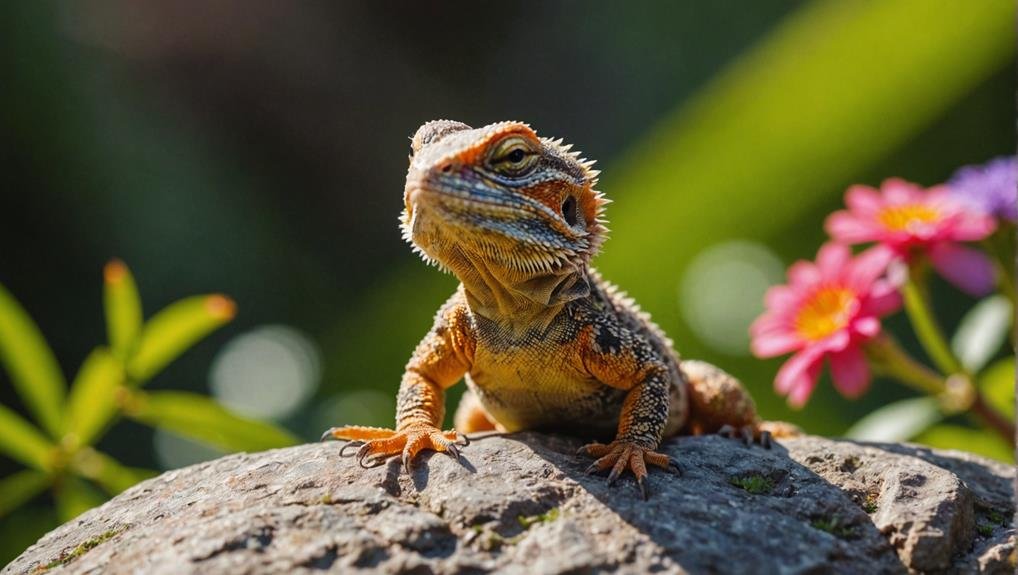When you bring a baby bearded dragon into your home, you commit to a specialized care routine different from adult dragons. It would be best to focus on providing a high-protein diet with smaller prey items and maintaining a carefully monitored habitat. You’ll need to adjust feeding habits and environment as they grow. Have you considered the ideal terrarium size or the specific lighting and heat requirements for these young reptiles? These factors can greatly impact their health and longevity, and there’s much more to discuss to ensure your baby beardie thrives.
Key Takeaways
- Baby beardies need a protein-rich diet and smaller, frequent prey items.
- A smaller, safe enclosure with vigilant temperature and humidity monitoring is essential.
- Ensure the basking surface temperature is between 105-115°F and maintain proper UVB lighting.
- Regular health check-ups and stress reduction are crucial for a long, healthy life.
- A spacious terrarium, at least 4x2x2 feet, aids in temperature regulation and growth.
Baby Vs. Adult Care


Caring for baby bearded dragons differs greatly from adult care, especially regarding their diet and habitat needs. Regarding diet, baby beardies need a higher protein intake to support their rapid growth, so you’ll need to feed them smaller prey items more frequently than you’d an adult. They can initially struggle with larger insects or greens, so patience and persistence during feeding are important.
Regarding habitat, baby bearded dragons require a smaller, safer enclosure to prevent them from getting lost or injured. You’ll also need to be vigilant about maintaining the right body temperature for them. A heat lamp is essential to provide warmth, but the temperature must be monitored closely. Babies’ specific temperature and humidity needs differ from adults, so you must adjust these factors to ensure their well-being.
Handling should be minimal and gentle because baby beardies are more fragile and stress-prone. Over-handling can cause harm, so limit interactions until they’ve grown stronger.
Lifespan of Bearded Dragons
A bearded dragon‘s lifespan can range from 10 to 15 years, especially when cared for in ideal conditions. To guarantee your bearded dragon reaches its maximum lifespan, you must provide proper care, including a suitable diet, a clean habitat, and regular health check-ups.
Good nutrition is key; offering a balanced diet of insects, vegetables, and occasional fruits can keep your dragon healthy and thriving.
Your dragon’s environment plays an essential role, too. Maintaining the right temperature and humidity levels and a clean and spacious enclosure can prevent health issues and stress. Stress reduction is crucial because chronic stress can greatly shorten a bearded dragon’s lifespan.
Regular vet visits are important. A veterinarian experienced with reptiles can help you spot potential health problems early and offer guidance on providing the best care.
Remember, baby bearded dragons grow rapidly within their first year, reaching full size by 18 months. Proper care during this important growth period sets the stage for a long, healthy life.
In short, your commitment to proper care can make all the difference in ensuring that your bearded dragon lives a long, happy life.
Ideal Terrarium Size


For a baby bearded dragon, you’ll need at least a 4x2x2 feet terrarium to provide ample space for growth and movement. This size, equivalent to 120 gallons, guarantees your young reptile has enough room to explore and exercise.
A larger enclosure, like a 7x2x2 feet tank, offers even more benefits as it accommodates their rapid growth and active nature.
A spacious terrarium is essential for several reasons:
- Temperature Regulation: A larger space allows for better heat distribution, vital for maintaining the ideal temperature gradients necessary for your bearded dragon’s health.
- Basking Areas: Multiple basking spots can be set up, ensuring your dragon can easily access the warmth they need to digest food and stay healthy.
- Exercise: More room means your dragon can move around and exercise, promoting good muscle development and overall well-being.
- Future Growth: Investing in a larger terrarium from the start saves you money and hassle as your dragon grows, eliminating the need to upgrade their habitat frequently.
Heating and Lighting Needs
Ensuring your baby bearded dragon’s terrarium has the appropriate heating and lighting is essential for their health and development. Baby bearded dragons need a basking surface temperature of 105-115°F to aid digestion and regulate their metabolism. A halogen heat lamp creates a warm spot where your dragon can bask and adjust its body temperature. Additionally, the terrarium should have a cool zone with temperatures ranging from 70-85°F to allow for proper thermoregulation and comfort.
Proper UVB lighting is critical for your baby bearded dragon’s growth and development. UVB light promotes calcium absorption, essential for bone health and overall well-being. Ensure the UVB light source is within the recommended distance from your dragon to maximize its effectiveness.
Interestingly, bearded dragons have a ‘third eye’ on top of their heads, technically known as the parietal eye. This light-sensitive organ helps them detect changes in light and shadows, aiding their survival. Maintaining appropriate lighting conditions in the terrarium supports this unique feature.
Remember to keep humidity levels between 30% and 60%. High humidity can lead to respiratory issues, so monitoring and controlling it is essential for your baby bearded dragon’s health.
Feeding Guidelines


Feeding your baby bearded dragon a well-rounded diet is essential for its growth and development. Getting the right nutrients, including vitamin D, guarantees it will stay healthy and active.
Here’s how you can provide the best nutrition for your little friend:
- Daily Insects: Feed them insects high in protein, like crickets and mealworms. These provide the essential building blocks for growth.
- Gut-Load and Dust: Before feeding the insects, gut-load them with nutritious foods and dust them with calcium and vitamin supplements. This extra step assures your dragon gets the necessary nutrients.
- Varied Greens: Offer a variety of greens, such as kale and dandelions. These leafy veggies are rich in essential vitamins and aid in digestion. Avoid fruits as they can cause digestive issues.
- Hydration Through Food: Proper hydration is important. Offer foods like collard greens and squash, which contain high water content to support digestion and overall health.
Conclusion
Caring for a baby bearded dragon can be rewarding if you know the essentials. You’ll need to adjust their diet over time, keep a close eye on their habitat’s temperature and humidity, and provide the right terrarium size and lighting.
Patience and consistency are key. You’re setting your bearded dragon up for a healthy and long life by meeting these needs. Enjoy every step of watching your little reptile grow!


